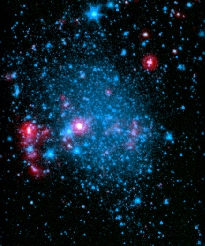UGC 4305
| Galaxy UGC 4305 / Holmberg II |
|
|---|---|
| The UGC 4305 galaxy captured by the Spitzer Space Telescope . | |
| AladinLite | |
| Constellation | Big Bear |
|
Position equinox : J2000.0 , epoch : J2000.0 |
|
| Right ascension | 08 h 19 m 05.0 s |
| declination | + 70 ° 43 ′ 12 ″ |
| Appearance | |
| Morphological type | in the |
| Brightness (visual) | 11.1 mag |
| Brightness (B-band) | 11.38 mag |
| Angular expansion | 7.9 ′ × 6.3 ′ |
| Physical data | |
| Affiliation | M81 group , LGG 176 |
| Redshift | 0.000474 ± 0.000003 |
| Radial velocity | (142 ± 1) km / s |
|
Stroke distance v rad / H 0 |
(11 ± 1) x 10 6 ly (3.48 ± 0.25) Mpc |
| diameter | 30,000 ly |
| history | |
| discovery | Erik Bertil Holmberg |
| Discovery date | 1950s |
| Catalog names | |
| UGC 4305 • PGC 23324 • CGCG 331-034 • MCG + 12-08-033 • IRAS 08140 + 7052 • Arp 268 • DDO 50 • Holmberg II • KUG 0814 + 708 • LDCE 0842 NED002 | |
UGC 4305 = Arp 268 , also known as Holmberg II after its discoverer , is a dwarf galaxy in the constellation Great Bear , about 11 million light years away from the Milky Way . Halton Arp organized his catalog of unusual galaxies into groups according to purely morphological criteria. This galaxy belongs to the class of galaxies with irregular clusters . According to the latest investigations, there is a moderate black hole in UGC 4305 .
The UGC 4305 galaxy was discovered by the Swedish astronomer Erik Bertil Holmberg in the 1950s .
Web links
- Black Hole - Holmberg II Galaxy (PDF file; 259 kB)
- Holmberg II Dwarf Irregular Galaxy
- Arp Atlas of Peculiar Galaxies
- Seligman Arp
literature
- Jeff Kanipe and Dennis Webb: The Arp Atlas of Peculiar Galaxies - A Chronicle and Observer's Guide , Richmond 2006, ISBN 978-0-943396-76-7

